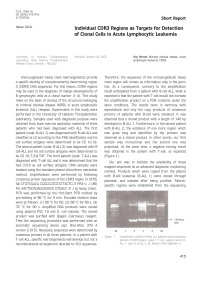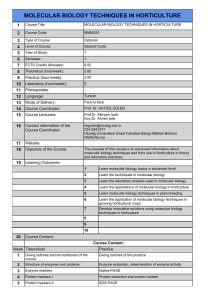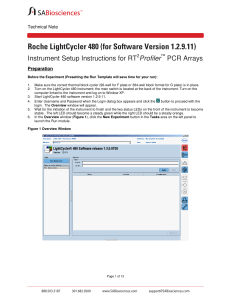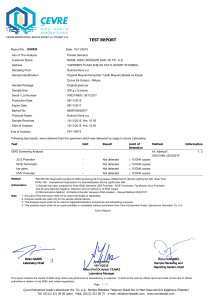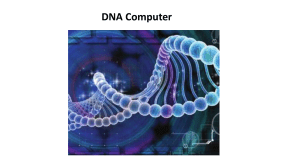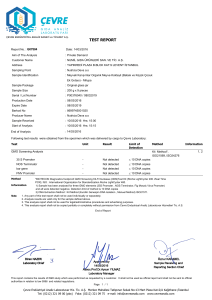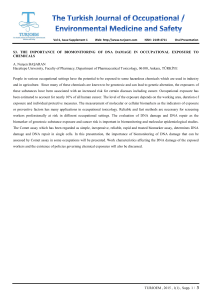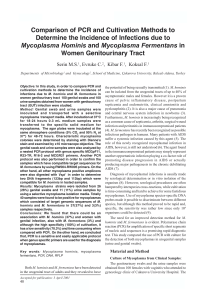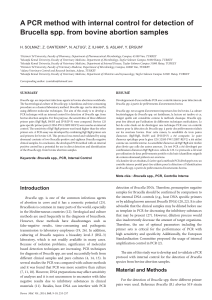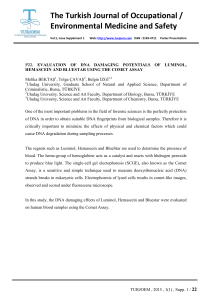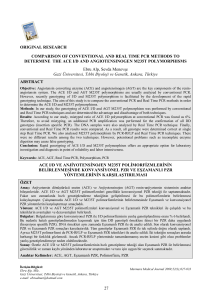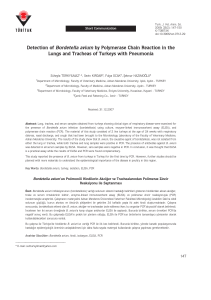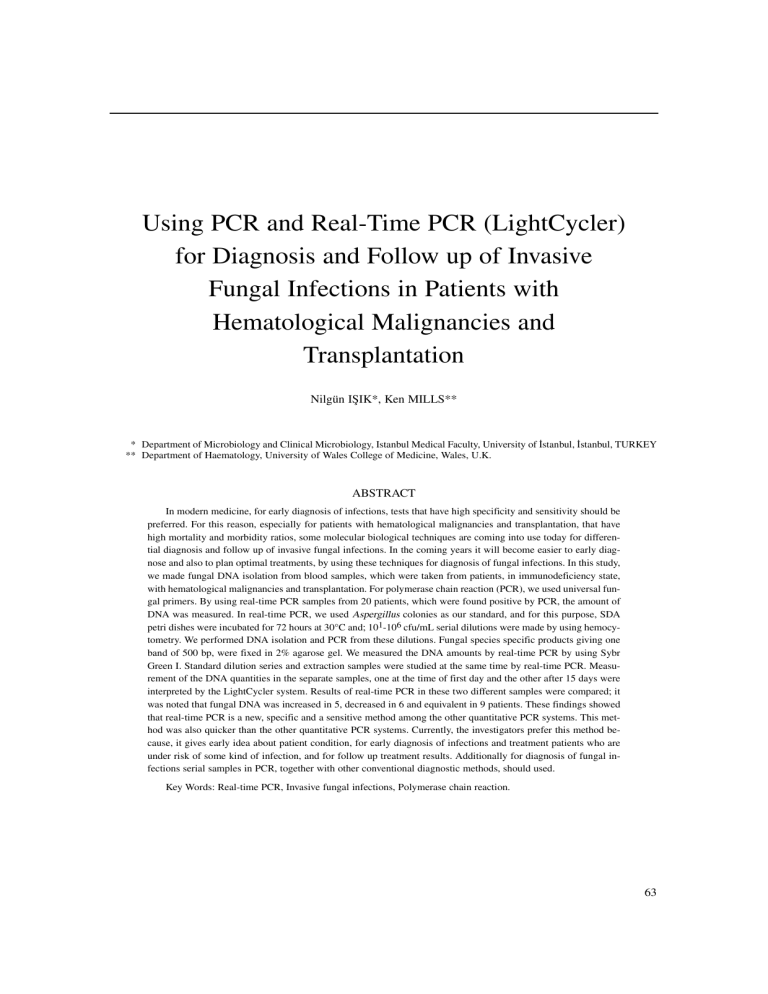
Using PCR and Real-Time PCR (LightCycler)
for Diagnosis and Follow up of Invasive
Fungal Infections in Patients with
Hematological Malignancies and
Transplantation
Nilgün IÞIK*, Ken MILLS**
* Department of Microbiology and Clinical Microbiology, Istanbul Medical Faculty, University of Ýstanbul, Ýstanbul, TURKEY
** Department of Haematology, University of Wales College of Medicine, Wales, U.K.
ABSTRACT
In modern medicine, for early diagnosis of infections, tests that have high specificity and sensitivity should be
preferred. For this reason, especially for patients with hematological malignancies and transplantation, that have
high mortality and morbidity ratios, some molecular biological techniques are coming into use today for differential diagnosis and follow up of invasive fungal infections. In the coming years it will become easier to early diagnose and also to plan optimal treatments, by using these techniques for diagnosis of fungal infections. In this study,
we made fungal DNA isolation from blood samples, which were taken from patients, in immunodeficiency state,
with hematological malignancies and transplantation. For polymerase chain reaction (PCR), we used universal fungal primers. By using real-time PCR samples from 20 patients, which were found positive by PCR, the amount of
DNA was measured. In real-time PCR, we used Aspergillus colonies as our standard, and for this purpose, SDA
petri dishes were incubated for 72 hours at 30°C and; 101-106 cfu/mL serial dilutions were made by using hemocytometry. We performed DNA isolation and PCR from these dilutions. Fungal species specific products giving one
band of 500 bp, were fixed in 2% agarose gel. We measured the DNA amounts by real-time PCR by using Sybr
Green I. Standard dilution series and extraction samples were studied at the same time by real-time PCR. Measurement of the DNA quantities in the separate samples, one at the time of first day and the other after 15 days were
interpreted by the LightCycler system. Results of real-time PCR in these two different samples were compared; it
was noted that fungal DNA was increased in 5, decreased in 6 and equivalent in 9 patients. These findings showed
that real-time PCR is a new, specific and a sensitive method among the other quantitative PCR systems. This method was also quicker than the other quantitative PCR systems. Currently, the investigators prefer this method because, it gives early idea about patient condition, for early diagnosis of infections and treatment patients who are
under risk of some kind of infection, and for follow up treatment results. Additionally for diagnosis of fungal infections serial samples in PCR, together with other conventional diagnostic methods, should used.
Key Words: Real-time PCR, Invasive fungal infections, Polymerase chain reaction.
63
Using PCR and Real-Time PCR (LightCycler) for Diagnosis and
Follow up of Invasive Fungal Infections in Patients with
Hematological Malignancies and Transplantation
Iþýk N, Mills K.
ÖZET
Hematolojik Maligniteli Olup Nakil Yapýlan Hastalarda Fungal Ýnfeksiyonlarýn
Taný ve Ýzlenmesinde PCR ve Real-Time PCR (LightCycler) Kullanýmý
Yüksek mortalite ve morbiditeye sahip olan hematolojik maligniteli ve nakil yapýlmýþ hastalarda, invaziv fungal infeksiyonlarýn tanýsý ve izlenmesi için yüksek duyarlýlýk ve özgüllüðe sahip moleküler biyolojik tekniklerin
kullanýlmasý gündemdedir. Bu çalýþmada hastalardan immünyetmezlik dönemde alýnan kan örneklerinden fungal
DNA izole edildi. PCR için üniversal fungal primerler kullanýldý. PCR ile pozitif bulunan 20 olguda real-time PCR
ile DNA miktarý ölçüldü. Real-time PCR’de Aspergillus kolonileri kontrol olarak kullanýldý. DNA miktar ölçümü
Sybr Green I ile yapýldý. Standart dilüsyon serileri ve ekstraksiyon örnekleri real-time PCR ile ayný zamanda ölçüldü. DNA miktar ölçümleri, birinci gün ve 15. gün örneklerinde LightCycler ile yapýldý. Bu iki örnekteki real-time
PCR sonuçlarý karþýlaþtýrýldý. Fungal DNA’nýn beþ olguda arttýðý, altý olguda azaldýðý dokuz olguda ayný kaldýðý
görüldü. Bu bulgular real-time PCR’nin diðer kantitatif PCR yöntemlerine göre daha duyarlý ve özgül olduðunu ve
diðer sistemlerden hýzlý olduðunu göstermektedir. Halen araþtýrmacýlar bu yöntemi hastanýn durumu hakkýnda erken bilgi vermesi, infeksiyonlarýn erken tanýsý ve tedavinin izlenmesinde kullanýlabilmesi nedeni ile tercih etmektedir. Fungal infeksiyonlarýn tanýsýnda seri PCR örneklerinin izlenmesi ve diðer konvansiyonel yöntemlerin de kullanýlmasý yararlý olacaktýr.
Anahtar Kelimeler: Real-time PCR, Ýnvaziv fungal infeksiyon, Polimeraz zincir reaksiyonu.
Turk J Haematol 2003;20(2): 63-68
Received: 29.04.2002
Accepted: 04.11.2002
INTRODUCTION
Present evolution of molecular biology has led researchers clone and organize process of nucleic acid
from individual genes. These procedures can also be
applied to fungal genes. Development of PCR technology made it possible to rapidly identify different types
of pathogenes in clinical mycology[1]. PCR is one of
the most significant techniques, which come over the
problems of low sensitivity and specificity[2]. Deep
fungal infections cannot usually be diagnosed until the
late stage especially in patients with immunosuppression, haematological malignancy or transplantation. At
this stage all therapeutic modalities have little chance
of success[3]. However, in case of rapid identification
of fungal infections with highly sensitive and specific
techniques with molecular biology it will not be necessary for the clinician to wait for culture results or start
treatment with a presumptive clinical indication. Our
aim in this study was determined the reliability and value of PCR in diagnosis of invasive fungal infections.
Using real-time PCR (Light-Cycler) we have quantitatively identified the amount of fungal DNA in blood
samples obtained from patients with proven fungal infection at the time of diagnosis and 15 days later.
MATERIALS and METHODS
In this study, we used a well-working PCR technique and modified real-time PCR protocols with using
64
Sybr-Green which were established by Einsele et al
120-blood samples anticoagulated with EDTA, which
were taken from patients, immunosuppressed, with hematological malignancies and transplantation[4,5]. We
selected the patients whose were under a risk of developing fungal infections. DNA isolation was done
using by QIA-amp tissue kit (Qiagen). After that, at
thermal cycler, 35 cycles (30 sec at 94°C, 1 min at
62°C, 2 min at 72°C) amplification was made by using
18S rRNA (5’-ATT GGA GGG CAA GTC TGG TG
and 5’-CGG ATC CCT AGT CGG CAT AG) as universal fungal primers which were more suitable primer pairs for fungal PCR[5]. Sterile distile water was used as
negative control for PCR. Aspergillus fumigatus were
cultured on Sabouraud Dextrose agar (SDA) for 72 hours at 30°C and DNA was extracted from A. fumigatus
colonies and this DNA isolates were used as positive
control for PCR. In addition to this, in real-time PCR,
we used Aspergillus colonies as our standard, and for
this purpose, SDA petri dishes were incubated and;
101-106 cfu/mL serial dilutions were made by using
hemocytometry. After PCR, all products were shown at
2% agarose gel fungal species specific products giving
one band of 500 bp, were fixed in agarose gel, represented as positive, samples which were found positive
by PCR, the amount of DNA was measured by using
real-time PCR[6,7]. Measurement of the DNA quantities in the separate samples of the same patients, one at
Turk J Haematol 2003;20(2):63-68
Using PCR and Real-Time PCR (LightCycler) for Diagnosis and
Follow up of Invasive Fungal Infections in Patients with
Hematological Malignancies and Transplantation
ween 3-20 days. We confirmed positive samples by
using culture and to sequencing. We sequenced [by
ABI Prism 377 (Perkin Elmer)] positive samples and
all had given A. fumigatus specific base pairs. All positive patients had taken antifungal therapy following
the first day PCR result. After antifungal treatment
only five patients who had increased amount of DNA
whose were three of them died and two of them decreased DNA amount after 20 days later to taking antifungal therapy. Results of measurement of the DNA amounts, by real-time PCR in separate samples of 20 patients with fungal infection, one at the time of diagnosis
and other after 15 days were shown in Table 1. Real-time PCR standard curve results, in which positive
sample results were analyzed are shown in Figure 2.
According to first sample results fungal DNA amounts
for five patients were found 105-106 cfu/mL; for ten
patients, 104-105 cfu/mL; for four patients, 103-104
cfu/mL; and for one patient, 101-102 cfu/mL. The results for the samples taken after 15 days for two patients were >106 cfu/mL, for two patients, 105-106
cfu/mL; for eleven patients, 104-105 cfu/mL and for five patients 103-104 cfu/mL.
Finally, if we compare results of first samples and
Classical PCR Results
Real-time PCR Results
}
}
the time of diagnosis and the other after 15 days were
repeated, results were compared to each other and interpreted by the real-time PCR system. Real-time PCR
was performed in glass capillaries which ensures rapid
equilibration between the air and the reaction components because of the high surface to volume ratio of the
capillaries. So that, results were taken in short time.
There was a system in which every amplification step
was shown. In this system, special probes and same
fluorescent dyes were used, as we done especially
Sybr-Green I was preferred. In this system, there is also an optic reader, which measures the rising of fluorescent dye with increasing amount of DNA in each
cycle of amplification. Sybr-Green I is double-stranded
DNA selective fluorescent dye, provides rapid way to
detect increase in DNA amount. In tubes, in every
cycle of amplification, when amount of double stranded DNA increases, binding to this and amount of dye
which gives fluorescence also increases. By means of
melting curve analysis, we decided whether amplified
DNA is target area or not. After amplification completed, tubes which contain PCR products were heated
slowly, while fluorescence observed. At certain degree
(melting point), DNA strands apart from each other
and give fluorescent dye free and fluorescence decreases immediately. This melting point depends on
length of amplified DNA and GC/AT ratios. If this ratio is high, there are more hydrogen bands between two
strands. So temperature, which is needed to convert the
double stranded DNA to single stranded DNA increases proportionally with this ratio. Every product has
specific melting point, because every product has specific length and genome content. It is understood that if
this product was wanted or not, by looking at melting
points of products. In this study, results are taken from
printers as cfu/mL, after 30 min following the 35
cycles amplification program[4]. After PCR, products
were observed at agarose gel.
Iþýk N, Mills K.
M 1
2
3 4
5 6
7
8 9 10 11 12 M
1000 bp
750 bp
500 bp
300 bp
150 bp
50 bp
Orders: M: Molecular weight standard (PCR Marker: Sigma P9577)
1 and 9: First sample,
RESULTS
Fungal infections were detected in twenty of 120
blood samples of patients with immunodeficiency state by PCR after extraction. After 15 days another blood sample were taken from the same patients and amount of DNA was measured by real-time PCR. Results
of only four positive patients samples by PCR and real-time PCR at 2% agarose gel are shown in Figure 1.
All patients’ results were found positive by culture bet-
Turk J Haematol 2003;20(2):63-68
2 and 10: Second sample,
3 and 11: Third sample,
4 and 12: Fourth sample,
5 and 8: Negative control (sterile distilled water),
6 and 7: Positive control (105-106 cfu/mL A. fumigatus).
Figure 1. PCR and real-time PCR results for four patient samples.
65
Using PCR and Real-Time PCR (LightCycler) for Diagnosis and
Follow up of Invasive Fungal Infections in Patients with
Hematological Malignancies and Transplantation
Iþýk N, Mills K.
samples taken after 15 days; real-time PCR of amounts
of fungal DNA increased for five patients, decreased for
six patients and remained the same for nine patients. So
that, while considering DNA levels, antifungal treatment
protocols were replanned.
DISCUSSION
Incidence of invasive fungal infection has increased
especially in immunodeficient patients. This is true for
patients who receive chemotherapy for hematologic malignancies, patients having immunosuppressive treatment after organ transplantation, patients with AIDS or
nosocomial infections as well[8-10]. Such patients with
immunosuppression are the ones who need most the
molecular methods for nucleic acid analysis. Fungal
infections in such patients show rapid progression and
cause highly lethal complications if proper treatment
cannot be offered. This is why we need rapid and highly sensitive diagnostic methods[11,12]. Methods like
PCR and real-time PCR (which has quantitative property as well) are developed in recent years. Loeffler et
al reported on using real-time PCR for the diagnosis of
fungal infections and determining the amount of
DNA[4]. Furthermore real-time PCR is also used for diagnosis of many viral or bacterial infections[13,14].
There are many studies on PCR for early diagnosis of
invasive fungal infections. Conclusion was that PCR,
compared to blood cultures and ELISA, is much more
sensitive and specific for determining fungal antigens
and antibodies[15-17]. In this study, we have used PCR
and real-time PCR for the early diagnosis of invasive
fungal infections in 120 samples obtained from patients with transplantation or hematologic malignancies.
PCR was positive in 20 patients whose initial samples
and samples taken 15 days later were further analyzed
by real-time PCR for determining the amount of DNA.
When results of real-time PCR in these two different
samples were compared; it was noted that fungal DNA
was increased in five (three of them died and two of
them decreased DNA amount after 20 days later to taking antifungal therapy), decreased in six and equivalent in nine patients. According to these results antifun-
Table 1. Real-time PCR results (cfu/mL)
Patients
1
2
3
4
5
6
7
8
9
10
11
12
13
14
15
16
17
18
19
20
Real-time PCR result I
(first sample results)
103-104
104-105
104-105
104-105
104-105
103-104
103-104
104-105
104-105
103-104
104-105
105-106
105-106
104-105
104-105
105-106
105-106
104-105
105-106
101-102
Real-time PCR result II
(sample results after 15 days)
105-106
104-105
> 106
104-105
104-105
104-105
103-104
104-105
104-105
103-104
103-104
103-104
104-105
105-106
104-105
103-104
104-105
104-105
104-105
> 106
Comparison of real-time
PCR result I and II
↑
→
↑
→
→
↑
→
→
→
→
↓
↓
↓
↑
→
↓
↓
→
↓
↑
↑: Increase, ↓: Decrease, →: Same level.
66
Turk J Haematol 2003;20(2):63-68
Using PCR and Real-Time PCR (LightCycler) for Diagnosis and
Follow up of Invasive Fungal Infections in Patients with
Hematological Malignancies and Transplantation
Iþýk N, Mills K.
30
A
Cycle number
25
20
15
10
5
1
1.5
2
2.5
3
3.5
4
4.5
5
5.5
6
Log concentration
30
B
Cycle number
25
20
15
10
5
0.5
1
1.5
2
2.5
3
3.5
4
4.5
5
Log concentration
A: For first samples (101-106 cfu/mL)
B: For samples after 15 days (101-106 cfu/mL)
Figure 2. Real-time PCR standard curves in which positive results were analyzed.
gal treatment protocols were reestablished. As a result
early diagnosis in these patients provided proper treatment and follow up. Comparing to both sample results,
treatment protocols replanned according to amount of
DNA detected in samples taken after 15 days.
As a conclusion, PCR and real-time PCR are the
newest, specific and sensitive techniques. Compared to
others both provide rapid results and give early idea
about patient’s condition whose are under a risk of fungal infections. On the other hand, PCR and real-time
PCR should be performed for serial samples and toget-
Turk J Haematol 2003;20(2):63-68
her with conventional diagnostic methods.
REFERENCES
1.
2.
3.
Mitchell TG, Sandin RL, Bowman BH, Meyer W, Merz
WG. Molecular mycology: DNA probes and applications of PCR technology. J Med Vet Mycol
1994;32(Suppl 1):351-66.
Jones JM. Laboratory diagnosis of invasive candidiasis.
Clin Microbiol Rev 1990;3:32-45.
Walsh TJ, Hiemenz JW, Anaissie E. Recent progress and
current problems in treatment of invasive fungal infections in neutropenic patients. Infect Dis Clin North Am
67
Iþýk N, Mills K.
4.
5.
6.
7.
8.
9.
10.
11.
12.
13.
14.
15.
16.
17.
68
1996;10:365-400.
Loeffler J, Henke N, Hebart H, Schmidt D, Hagmeyer L,
Schumacher U, Einsele H. Quantification of fungal
DNA by using fluorescence resonance energy transfer
and the light cycler system. J Clin Microbiol
2000;38:586-90.
Loeffler J, Hebart H, Schumacher U, Reitze H, Einsele
H. Comparison of different methods for extraction of
DNA of fungal pathogens from cultures and blood. J
Clin Microbiol 1997;35:3311-2.
Kan VL. Polymerase chain reaction for the diagnosis of
candidemia. J Infect Dis 1993;168:779-83.
Kappe R, Okeke CN, Fauser C, Maiwald M, Sonntag
HG. Molecular probes for the detection of pathogenic
fungi in the presence of human tissue. J Med Microbiol
1998;47:811-20.
Pfaller M, Wenzel R. Impact of the changing epidemiology of fungal infections in the 1990s. Eur J Clin Microbiol Infect Dis 1992;11:287-91.
Georgopapadakou NH, Walsh TJ. Antifungal agents:
Chemotherapeutic targets and immunologic strategies.
Antimicrob Agents Chemother 1996; 40:279-91.
Denning DW. Epidemiology and pathogenesis of systemic fungal infections in the immunocompromised host.
J Antimicrob Chemother 1991;28(Suppl B):1-16.
Reiss E, Obayashi T, Orle K, Yoshida M, Zancope-Oliveira RM. Non-culture based diagnostic tests for mycotic infections. Med Mycol 2000;38(Suppl 1):147-59.
Loeffler J, Hebart H, Cox P, Flues N, Schumacher U,
Einsele H. Nucleic acid sequence-based amplification of
Aspergillus RNA in blood samples. J Clin Microbiol
2001;39:1626-9.
Brechtbuehl K, Whalley SA, Dusheiko GM, Saunders
NA. A rapid real-time quantitative polymerase chain reaction for hepatitis B virus. J Virol Methods
2001;93:105-13.
Schaade L, Kockelkorn P, Ritter K, Kleines M. Detection of cytomegalovirus DNA in human specimens by
LightCycler PCR. J Clin Microbiol 2000; 38:4006-9.
Hebart H, Loeffler J, Meisner C, Serey F, Schmidt D,
Bohme A, Martin H, Engel A, Bunje D, Kern WV, Schumacher U, Kanz L, Einsele H. Early detection of Aspergillus infection after allogeneic stem cell transplantation
by polymerase chain reaction screening. J Infect Dis
2000;181:1713-9.
Makimura K, Murayama SY, Yamaguchi H. Detection
of a wide range of medically important fungi by the
polymerase chain reaction. J Med Microbiol
1994;40:358-64.
Skladny H, Buchheidt D, Baust C, Krieg-Schneider F,
Seifarth W, Leib-Mosch C, Hehlmann R. Specific detection of Aspergillus species in blood and bronchoalveolar
lavage samples of immunocompromised patients by
two-step PCR. J Clin Microbiol 1999; 37:3865-71.
Using PCR and Real-Time PCR (LightCycler) for Diagnosis and
Follow up of Invasive Fungal Infections in Patients with
Hematological Malignancies and Transplantation
Address for Correspondence:
Nilgün IÞIK, MD
Department of Microbiology and
Clinical Microbiology
Ýstanbul Medical Faculty, University of Ýstanbul
Ýstanbul, TURKEY
Turk J Haematol 2003;20(2):63-68

